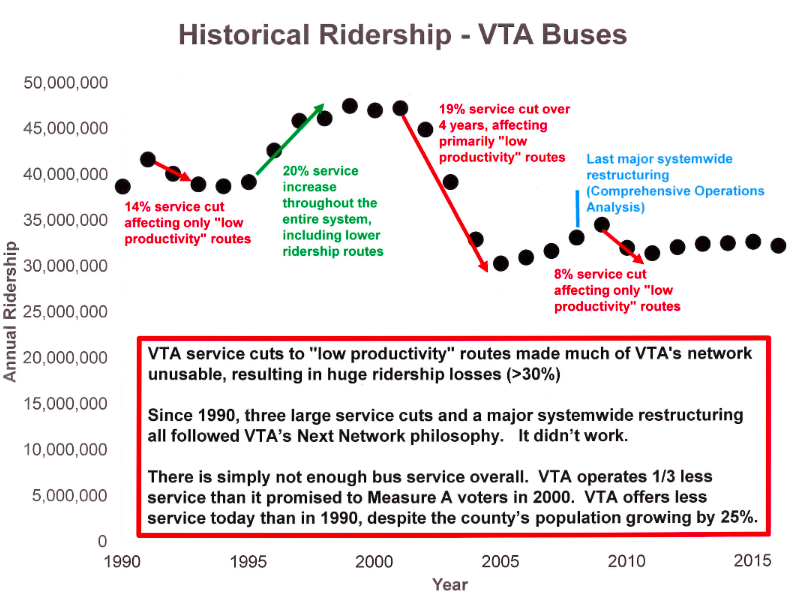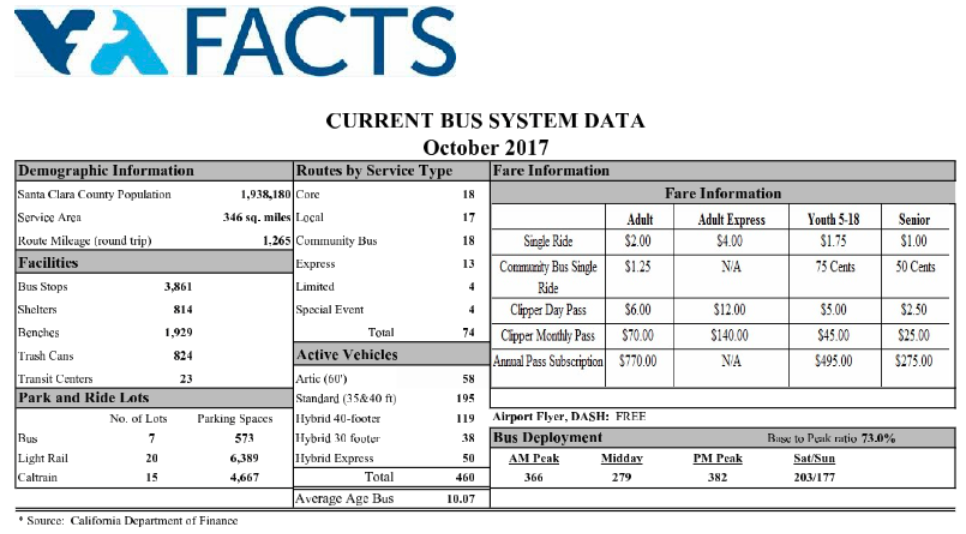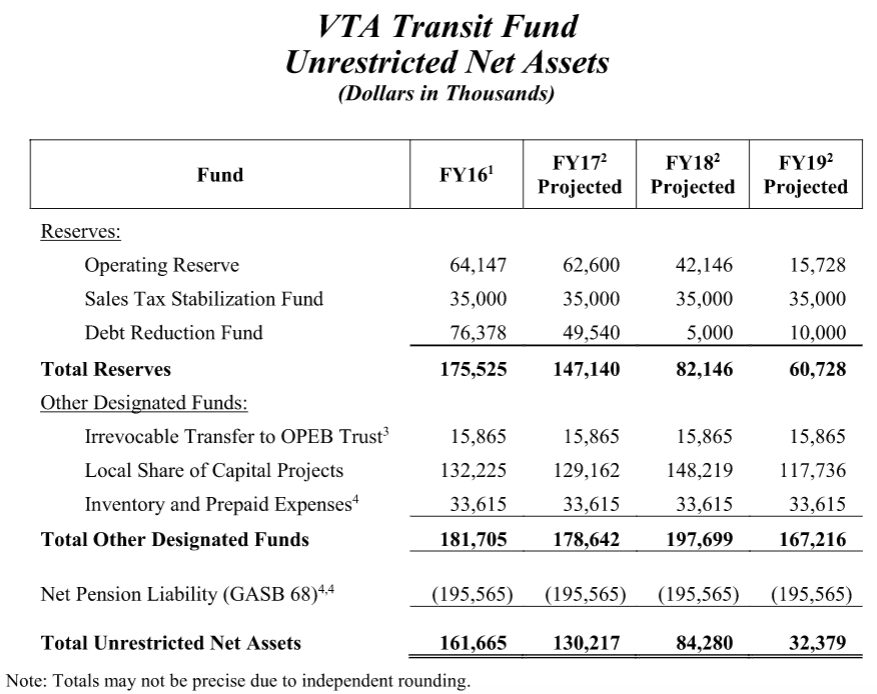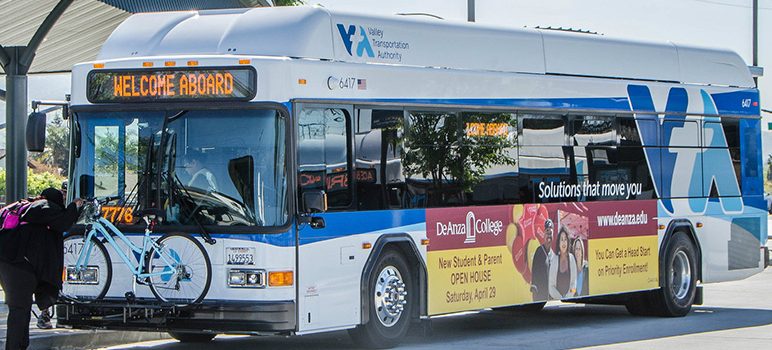San Jose Mayor Sam Liccardo wants to repeat failed history.
In his first chairperson’s report at the Jan. 4 Santa Clara Valley Transportation Authority (VTA) Board Of Directors meeting, Liccardo advocated for further reductions in transit service to help close a $20 million operating deficit this fiscal year, and a $26 million operating deficit in 2019. He announced the formation of a committee to address VTA’s structural operating deficit, and provide solutions. The gist of his comments start at the two-minute mark of the following audio clip.
Learn more about how this service cut strategy fails to resolve any VTA operating deficit—and what you can proactively do to change history in your favor—below.
Background
On Feb. 1, the VTA board approved a formal list of who is on the “Ad-Hoc Financial Stability Committee.” That committee will be headed by Jeannie Bruins, last year’s VTA board chair, and will represent “small city groups.” Fellow VTA board member and Santa Clara County Supervisor Cindy Chavez will represent unincorporated areas while fellow board member and San Jose City Councilman Johnny Khamis, will represent San Jose.
Here’s who else will be on this current edition of the ad-hoc committee:
- Santa Clara County City Managers Association
- Santa Clara Coalition of Chambers of Commerce
- Silicon Valley Leadership Group
- Transit Justice Alliance
- SPUR
- Amalgamated Transit Union Local 265
- Service Employees International Union (SEIU) Local 521
- Transportation Authority Engineers & Architects Association (TAEA) Local 21
- American Federation of State, County, and Municipal Employees Local 101 (AFSCME)
- South Bay AFL-CIO Labor Council
Note the lack of taxpayer, senior or disabled and environmental groups on the committee. Such groups are most likely to have the ideas needed to resolve VTA’s current fiscal crisis. Also note that the Transit Justice Alliance was convened by Working Partnerships USA, an organization that once employed Chavez.
This follows similar committees VTA formed in 2003 and 2010 to address prior operating shortfalls. Both past committees recommended transit service reductions to resolve operating deficits at the time.
Talking Points
Liccardo’s statements at the VTA board meeting in January contradict calls for the city to “reduce greenhouse gas emissions.” Worse still is that his advocacy for further cutting VTA service violates San Jose’s own General Plan 2040 goals. One of those goals: reducing vehicle miles traveled in San Jose by 40 percent within the next 22 years. For more about how Liccardo stands to exacerbate traffic gridlock in San Jose, click here.
 The chart above, courtesy of the Almaden Valley Community Association, shows VTA’s historical bus ridership. Now, VTA has a third less bus service than what it promised voters who approved Measure A back in 2000. Compare that chart to VTA’s own bus ridership and bus service facts, which you can see below.
The chart above, courtesy of the Almaden Valley Community Association, shows VTA’s historical bus ridership. Now, VTA has a third less bus service than what it promised voters who approved Measure A back in 2000. Compare that chart to VTA’s own bus ridership and bus service facts, which you can see below.
 Note that VTA has 12 percent fewer active buses, 7 percent fewer peak (rush hour) buses, 3 percent fewer total scheduled hours, and 17 percent fewer weekday riders now than when its predecessor, Santa Clara County Transit, had in 1988. That’s despite Santa Clara County’s population growing by over 23 percent between 1988 and 2017. One reason why VTA’s bus service has failed to keep up with the county’s population can be found in a report on where your sales tax money went.
Note that VTA has 12 percent fewer active buses, 7 percent fewer peak (rush hour) buses, 3 percent fewer total scheduled hours, and 17 percent fewer weekday riders now than when its predecessor, Santa Clara County Transit, had in 1988. That’s despite Santa Clara County’s population growing by over 23 percent between 1988 and 2017. One reason why VTA’s bus service has failed to keep up with the county’s population can be found in a report on where your sales tax money went.
Another factor not acknowledged publicly in the VTA’s latest “financial crisis?”
Unfunded pension liabilities.

The VTA owes over $195 million in unfunded pension liabilities. This can be found in VTA’s approved fiscal year 2018-19 biennial budget.
Remember Measure B, a transit and highways VTA ballot measure from November 2016? That money is currently tied up in appeals court, and thus “out of play.” No date has been announced as to the final appeals court verdict.
In terms of cities with public transit, Seattle is the current trendsetter. Meanwhile, Silicon Valley continues to be—at best—a trend follower and is on the path of being a trend repeater. Let’s change that now.
Starting Now, What Can I Do?
Let Liccardo know he must put public transit—especially buses—as a top priority instead of adding more auto traffic. Call him at 408.535.4800 or email him at
ma********@sa*******.gov
today.
This is especially important if you live in San Jose, because you are one of the managers he reports to. If you live outside San Jose, make sure to contact the VTA board member who represents your jurisdiction.
Also, if at all possible, come to Thursday’s VTA board meeting in San Jose and tell him face to face that he must prioritize transit—especially buses—in Santa Clara County. Here are the details for that meeting:
WHEN: 5:30pm Thursday
WHERE: County Government Center, 70 W. Hedding St., San Jose
GETTING THERE: VTA’s 61, 62, 66 and 180 express bus lines or light rail
MORE INFO: For further details on transit service in the area, read this map
During every VTA board meeting, the board chair—which is Liccardo this year—answers to you in the regular “Chairperson’s Report.” Learn how to be heard at any VTA public meeting here. If possible, request to speak after the chairperson’s report. Otherwise, request to speak during public comment at the start of the board meeting.
Beforehand, read up on VTA’s latest budget to learn where your sales tax money is going this year. Based on agency’s latest biennial budget, what do you think needs to be cut in terms of its operations budget? Please discuss in the comments.
In conclusion, let’s make sure failed history does not repeat itself.
Eugene Bradley is the founder of Silicon Valley Transit Users, an independent grassroots advocacy and watchdog group. This post was originally published Feb. 12 on www.svtransitusers.org. H/T to Adina Levin of the nonprofit Friends of Caltrain who alerted the author to Mayor Liccardo’s comments. Opinions are the author’s own and do not necessarily reflect those of San Jose Inside.


Let’s see. Every two years voters approve tax, fee or bonds to pay for transportation but it is never enough. Sam’s proposed service cuts are just an excuse to justify another tax increase.
Every time I see light rail running down First Street, it is empty save a few homeless people. It does, however, endlessly tie up traffic trying to cross First Street or make a left turn from First Street. I also see buses that pull to the curb, causing massive traffic jams, for perhaps a single rider to get on or off. The entire VTA system is a huge waste of money, goes nowhere that people actually need it to go, and in fact makes traffic and pollution much worse. Liccardo is right in this matter.
> Liccardo advocated for further reductions in transit service to help close a $20 million operating deficit this fiscal year, and a $26 million operating deficit in 2019.
————————–
> Liccardo is right in this matter.
————————-
A stopped clock is right twice a day.
I am told that BART’s yearly operating deficit is $200 million.
And when self-driving Ubers and Lyfts become common place, 19th century rail-based “public transit” will be as silly as steam-power rickshaws.
> Beforehand, read up on VTA’s latest budget to learn where your sales tax money is going this year.
“Public transit” is just a mobile warming shelter for homeless bums. It’s where taxpayer dollars go to die.
> Here’s who else will be on this current edition of the ad-hoc committee:
TEN clans of tax parasites. How did they leave out the global warming grifters?
Not a single tax payer organization.
Not a single business, organization, or consumer who wants potholes filled and better roads and facilities for PRIVATE cars and trucks.
The fix is in.